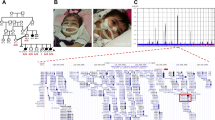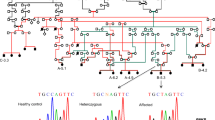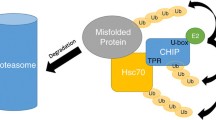Abstract
Nuclear pore complexes (NPCs) are the gateways of the nuclear envelope mediating transport between cytoplasm and nucleus. They form huge complexes of 125 MDa in vertebrates and consist of about 30 different nucleoporins present in multiple copies in each complex. Here, we describe pathogenic variants in the nucleoporin 93 (NUP93) associated with an autosomal recessive form of congenital ataxia. Two rare compound heterozygous variants of NUP93 were identified by whole exome sequencing in two brothers with isolated cerebellar atrophy: one missense variant (p.R537W) results in a protein which does not localize to NPCs and cannot functionally replace the wild type protein, whereas the variant (p.F699L) apparently supports NPC assembly. In addition to its recently described pathological role in steroid-resistant nephrotic syndrome, our work identifies NUP93 as a candidate gene for non-progressive congenital ataxia.




Similar content being viewed by others
Change history
05 March 2019
The original version of this article unfortunately contained mistake in Fig. 3 image.
References
Steinlin M. Nonprogressive congenital ataxias. Brain Dev. 1998;4:199–208.
Bertini E, Zanni G, Boltshauser E. Nonprogressive congenital ataxias. Handb Clin Neurol. 2018;155:91–103.
Zanni G, Bertini E. X-linked ataxias. Handb Clin Neurol. 2018;155:175–89.
Wente SR, Rout MP. The nuclear pore complex and nuclear transport. Cold Spring Harb Perspect Biol. 2010;2:a000562.
Beck M, Hurt E. The nuclear pore complex: understanding its function through structural insight. Nat Rev Mol Cell Biol. 2017;18:73–89.
Hezwani M, Fahrenkrog B. The functional versatility of the nuclear pore complex proteins. Semin Cell Dev Biol. 2017;68:2–9.
Vollmer B, Antonin W. The diverse roles of the Nup93/Nic96 complex proteins—structural scaffolds of the nuclear pore complex with additional cellular functions. Biol Chem. 2014;395:515–28.
Sachdev R, Sieverding C, Flotenmeyer M, Antonin W. The C-terminal domain of Nup93 is essential for assembly of the structural backbone of nuclear pore complexes. Mol Biol Cell. 2012;23:740–9.
Chug H, Trakhanov S, Hulsmann BB, Pleiner T, Gorlich D. Crystal structure of the metazoan Nup62*Nup58*Nup54 nucleoporin complex. Science. 2015;350:106–10.
von Appen A, Kosinski J, Sparks L, Ori A, Di Guilio AL, Vollmer B, et al. In situ structural analysis of the human nuclear pore complex. Nature. 2015;526:140–3.
Vollmer B, Schooley A, Sachdev R, Eisenhardt N, Schneider AM, Sieverding C, et al. Dimerization and direct membrane interaction of Nup53 contribute to nuclear pore complex assembly. EMBO J. 2012;31:4072–84.
Mansfeld J, Guttinger S, Hawryluk-Gara LA, Pante N, Mall M, Galy V, et al. The conserved transmembrane nucleoporin NDC1 is required for nuclear pore complex assembly in vertebrate cells. Mol Cell. 2006;22:93–103.
De Magistris P, Tatarek-Nossol M, Dewor M, Antonin W. A self-inhibitory interaction within Nup155 and membrane binding are required for nuclear pore complex formation. J Cell Sci. 2018;131(1). https://doi.org/10.1242/jcs.208538.
Mitchell JM, Mansfeld J, Capitanio J, Kutay U, Wozniak RW. Pom121 links two essential subcomplexes of the nuclear pore complex core to the membrane. J Cell Biol. 2010;191:505–21.
Braun DA, Sadowski CE, Kohl S, Lovric S, Astrinidis SA, Pabst WL, et al. Mutations in nuclear pore genes NUP93, NUP205 and XPO5 cause steroid-resistant nephrotic syndrome. Nat Genet. 2016;48:457–65.
Braun DA, Lovric S, Schapiro D, Schneider R, Marquez J, Asif M, et al. Mutations in multiple components of the nuclear pore complex cause nephrotic syndrome. J Clin Invest. 2018;128(10):4313–28. https://doi.org/10.1172/JCI98688.
Miyake N, Tsukaguchi H, Koshimizu E, Shono A, Matsunaga S, Shiina M, et al. Biallelic mutations in nuclear pore complex subunit NUP107 cause early-childhood-onset steroid-resistant nephrotic syndrome. Am J Hum Genet. 2015;97:555–66.
Park E, Ahn YH, Kang HG, Miyake N, Tsukaguchi H, Cheong HI. NUP107 mutations in children with steroid-resistant nephrotic syndrome. Nephrol Dial Transplant. 2017;32:1013–7.
Rosti RO, Sotak BN, Bielas SL, Bhat G, Silhavy JL, Aslanger AD, et al. Homozygous mutation in NUP107 leads to microcephaly with steroid-resistant nephrotic condition similar to Galloway-Mowat syndrome. J Med Genet. 2017;54:399–403.
Fujita A, Tsukaguchi H, Koshimizu E, Nakazato H, Itoh K, Kuraoka S, et al. Homozygous splicing mutation in NUP133 causes Galloway-Mowat syndrome. Ann Neurol. 2018;84:814–28. https://doi.org/10.1002/ana.25370.
Basel-Vanagaite L, Muncher L, Straussberg R, Pasmanik-Chor M, Yahav M, Rainshtein L, et al. Mutated nup62 causes autosomal recessive infantile bilateral striatal necrosis. Ann Neurol. 2006;60:214–22.
Tullio-Pelet A, Salomon R, Hadj-Rabia S, Mugnier C, de Laet MH, Chaouachi B, et al. Mutant WD-repeat protein in triple-a syndrome. Nat Genet. 2000;26:332–5.
Kortüm F, Caputo V, Bauer CK, Stella L, Ciolfi A, Alawi M, et al. Mutations in KCNH1 and ATP6V1B2 cause Zimmermann-Laband syndrome. Nat Genet. 2015;47:661–7.
McKenna A, Hanna M, Banks E, Sivachenko A, Cibulskis K, Kernytsky A, et al. The genome analysis toolkit: a MapReduce framework for analyzing next-generation DNA sequencing data. Genome Res. 2010;9:1297–303.
Sferra A, Baillat G, Rizza T, Barresi S, Flex E, Tasca G, et al. TBCE mutations cause early-onset progressive encephalopathy with distal spinal muscular atrophy. Am J Hum Genet. 2016;99:974–83.
Li H, Durbin R. Fast and accurate short read alignment with burrows-wheeler transform. Bioinformatics. 2009;25:1754–60.
Cingolani P, Platts A, le Wang L, Coon M, Nguyen T, Wang L, et al. A program for annotating and predicting the effects of single nucleotide polymorphisms, SnpEff: SNPs in the genome of Drosophila melanogaster strain w1118; iso-2; iso-3. Fly. 2012;6:80–92.
Liu X, Jian X, Boerwinkle E. dbNSFP v2.0: a database of human non-synonymous SNVs and their functional predictions and annotations. Hum Mutat. 2013;34:E2393–402.
Kircher M, Witten DM, Jain P, O'Roak BJ, Cooper GM, Shendure J. A general framework for estimating the relative pathogenicity of human genetic variants. Nat Genet. 2014;46:310–5.
Dong C, Wei P, Jian X, Gibbs R, Boerwinkle E, Wang K, et al. Comparison and integration of deleteriousness prediction methods for nonsynonymous SNVs in whole exome sequencing studies. Hum Mol Genet. 2015;24:2125–37.
Eisenhardt N, Schooley A, Antonin W. Xenopus in vitro assays to analyze the function of transmembrane nucleoporins and targeting of inner nuclear membrane proteins. Methods Cell Biol. 2014;122:193–218.
Theerthagiri G, Eisenhardt N, Schwarz H, Antonin W. The nucleoporin Nup188 controls passage of membrane proteins across the nuclear pore complex. J Cell Biol. 2010;189:1129–42.
Morlan J, Baker J, Sinicropi D. Mutation detection by real-time PCR: a simple, robust and highly selective method. PLoS One. 2009;4:e4584.
Kosinski J, Mosalaganti S, von Appen A, Teimer R, Di Guilio AL, Wan W, et al. Molecular architecture of the inner ring scaffold of the human nuclear pore complex. Science. 2016;352:363–5.
Nagata K, Randall A, Baldi P. SIDEpro: a novel machine learning approach for the fast and accurate prediction of side-chain conformations. Proteins. 2012;80:142–53.
Gant TM, Wilson KL. Nuclear assembly. Annu Rev Cell Dev Biol. 1997;13:669–95.
Grandi P, Dang T, Pane N, Shevchenko A, Mann M, Forbes D, et al. Nup93, a vertebrate homologue of yeast Nic96p, forms a complex with a novel 205-kDa protein and is required for correct nuclear pore assembly. Mol Biol Cell. 1997;8:2017–38.
Laurell E, Beck K, Krupina K, Theerthagiri G, Bodenmiller B, Horvath P, et al. Phosphorylation of Nup98 by multiple kinases is crucial for NPC disassembly during mitotic entry. Cell. 2011;144:539–50.
Linder MI, Kohler M, Boersema P, Weberruss M, Wandke C, Marino J, et al. Mitotic disassembly of nuclear pore complexes involves CDK1- and PLK1-mediated phosphorylation of key interconnecting nucleoporins. Dev Cell. 2017;43:141–156.e147.
Nofrini V, Di Giacomo D, Mecucci C. Nucleoporin genes in human diseases. Eur J Hum Genet. 2016;24:1388–95.
Neumann N, Lundin D, Poole AM. Comparative genomic evidence for a complete nuclear pore complex in the last eukaryotic common ancestor. PLoS One. 2010;5:e13241.
Stuwe T, Bley CJ, Thierbach K, Petrovic S, Schilbach S, Mayo DJ, et al. Architecture of the fungal nuclear pore inner ring complex. Science. 2015;350:56–64.
Koehler K, Brockmann K, Krumbholz M, Kind B, Bönnemann C, Gärtner J, et al. Axonal neuropathy with unusual pattern of amyotrophy and alacrima associated with a novel AAAS mutation p.Leu430Phe. Eur J Hum Genet. 2008;16:1499–506.
Acknowledgements
The authors thank the patients and their family for their participation in this study.
Funding
This work was supported by grants from the Italian Ministry of Health (Ricerca Finalizzata NET-2013-02356160 to E.B), Fondazione Bambino Gesù (Vite Coraggiose to M.T), and the German Research Foundation to W.A (AN377/7-1).
Author information
Authors and Affiliations
Contributions
Conceived and designed the project: GZ and WA. Performed the experiments: PDM, MN, EB, SB, AS, AC, MM, HL, and DMA. Analyzed the data: GZ, WA, EB, and MT. Contributed to the writing of the manuscript: GZ and WA. All authors approved the final version of this manuscript.
Corresponding authors
Ethics declarations
All studies were performed in accordance with the Declaration of Helsinki. Written informed consent was obtained from all participating subjects.
Conflict of Interest
The authors declare that they have no competing interests.
Additional information
Publisher’s Note
Springer Nature remains neutral with regard to jurisdictional claims in published maps and institutional affiliations.
The original version of this article was revised: The western blot presented in Figure b shows white lines has been corrected. Also the ESM3 was replaced.
Rights and permissions
About this article
Cite this article
Zanni, G., De Magistris, P., Nardella, M. et al. Biallelic Variants in the Nuclear Pore Complex Protein NUP93 Are Associated with Non-progressive Congenital Ataxia. Cerebellum 18, 422–432 (2019). https://doi.org/10.1007/s12311-019-1010-5
Published:
Issue Date:
DOI: https://doi.org/10.1007/s12311-019-1010-5




